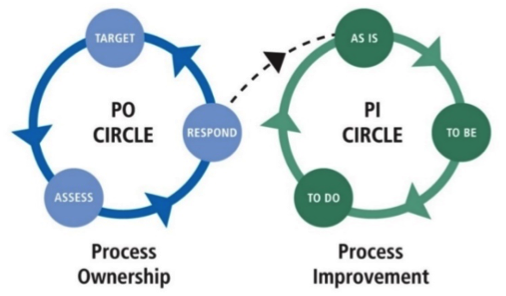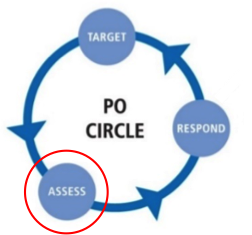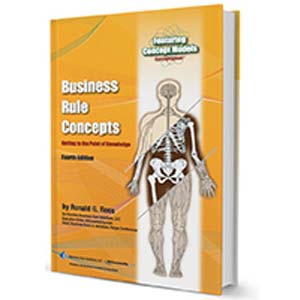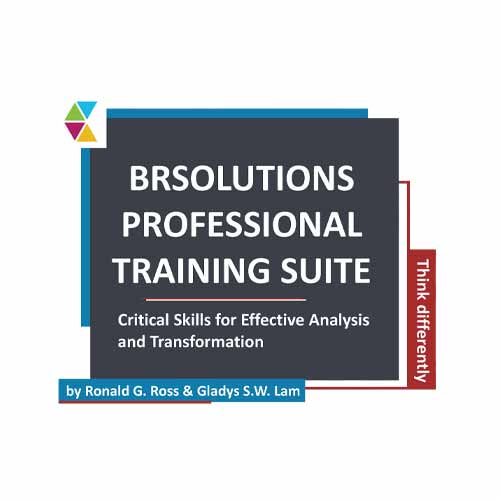Assess — Listening to the Voices
I am increasingly drawn to the term active process management, not just as an interesting adjectival phrase or a cryptic comment about an implied sense of frequency, but as a coherent management philosophy. Process management is not just a set of artifacts that are occasionally useful for management, but a core and continuous management approach.
Why active? Who needs to be active? What is activated? It's about two circles and six nodes, and one of those nodes in particular.
Get the circles turning
First, a quick review of what it means to get the circles turning.
To achieve and sustain genuine process-based management, processes are identified, performance targets are set, governance mechanisms are created, and process performance is improved in a process-aware culture where everyone contributes, and appropriate support is provided. For more detail read other columns about the 7Enablers of BPM here, here, and here.
How can this be achieved sustainably in the nitty gritty of our messy, volatile, and human organizations?
An elegant solution is found in two virtuous circles, the Tregear Circles — PO circle (process ownership) and PI circle (process improvement) — that facilitate and deliver process-based management (Figure 1).

Figure 1. Tregear Circles
I have written previous columns about the circles, and also in my book Reimagining Management, so just a short summary here.
The circles are more than an interesting diagram. They describe a meta-model for practical process-based management, one that can be used at once to deliver benefits quickly.
The PO circle is continually and deliberately testing the performance of a process to uncover actual or emergent performance gaps driven by measurement, and other opportunities driven by innovative ideas. The repeating cycle of target—assess—respond is the drumbeat of process-based management.
The PI circle is the process-improvement cycle that identifies the current state, defines the future state, and then makes evidence-based changes to close prioritized performance gaps. The PI circle can be instantiated with any process improvement methodology.
The PO circle determines whether process adjustment is required in response to a current or emergent performance anomaly, or a development opportunity; the PI circle discovers, details, and delivers the business-process change.
Conscious process-management activity starts with the PO circle. The requirement is to be continually aware of performance gaps or opportunities to challenge the status quo and making evidence-based decisions about which gaps need to be partially or completely closed, and in what order.
Many organizations do something like continuous process improvement; not enough do continuous process management. Turning the circles makes that possible.
Get the circles turning!
Assess

In this column I want to focus on the Assess node of the PO circle. This is where we listen to three different voices to enable evidence-based decisions about what, if any, change is justified, and in what timeframe it should be delivered.
These are the three voices of process-based management:
- Voice of the process (VoP)
- Voice of the stakeholders (VoS)
- Voice of the imagination (VoI)
It is the interplay of these voices that should drive process-based management.
Voice of the process
This voice is telling us about current performance and, if the process is operating predictably, what is likely to happen if there are no changes.
Performance measurement often focuses on looking back to what has happened. While that is obviously important, what we also want is the ability to look forward and predict what will happen next.
While it is important to understand and learn from what has already happened, an essential test of effective management is whether future performance can be predicted with any useful certainty? If not, management must be reactive rather than active, indicating a low level of control over the process and its outputs.
The best way to listen to this voice is through a Process Behavior Chart (PBC).
The PBC is a powerful process-based management tool. It answers the question "Has a change occurred?" If there has been a change, there will be a signal. If there was a signal, there was a change that is worth investigating. Importantly, the opposite is also true — we don't chase the routine noise in the absence of a signal.
Analyzed in a PBC, the process performance data alone tells us about process stability, variation limits, likely future performance, and whether an expected or unexpected change of consequence has occurred. Further detail in Signals in the Noise on my website.
Listen to the voice of the process. It tells us what is happening.
Voice of the stakeholders
Perhaps the more familiar term is Voice of the customer, but customers are not the only stakeholders, even if they are the most important.
Other key stakeholders might include suppliers, brokers, shareholders, staff, regulators, service providers, industry associations, accreditation authorities, etc. Each of these may have something important, perhaps even critical, to say about how a process should be performing to meet their requirements.
Not all stakeholders are equal, and they may even have conflicting and irreconcilable preferences. However difficult and demanding they might be, it is important to know who the key stakeholders are, what they give to or get from the process, how the process impacts them, and importantly, how they measure process performance. This voice is captured in the process KPIs and targets.
Listen to the voice of the stakeholders. It tells us what should be happening.
Voice of the imagination
In the first sketches of what became known as the Tregear Circles the PO node now shown as Assess was called Measure. It was focused solely on the measured performance of the process in relation to the assigned KPIs and targets.
Of course, this was very limiting. What about new ideas? A process might be achieving its performance targets and yet still be capable of significant improvement. For an airport check-in process (remember those?) we might measure and respond to average physical queue length, or we might consider the idea that travelers need not check-in at all.
Innovation management should not be separated from process improvement. Both have the same goal of performance improvement, even if at different scales and impact potentials.
Of course, it is necessary to focus on current process performance problems. If a process is not meeting its KPI targets, then that's a problem that must be solved. Having processes meet their agreed KPI targets is the main game. However, we should not do that exclusively.
At the Assess node we integrate performance management and idea management.
Listen to the voice of the imagination. It tells us what could be happening.
Listen to the voices
Listen to, and act on, what the voices are saying about the performance of the process – how it is performing, how it should perform, how it could perform.
Optimum performance for a process is found in the is-should-could sweet spot.
Finding that sweet spot requires active process management:
- Identify a target process within a process hierarchy (architecture)
- Appoint a Process Owner
- Engage the stakeholders
- Discover process KPIs and targets
- Collect the data, plot the dots on a PBC
- Assess performance and ideas
- Respond to the voices
- Repeat
This is active process management. It is:
- Focused on the processes by which an organization creates, accumulates, and delivers value to customer and other stakeholders, i.e., how strategy is executed.
- Consciously managing those processes to ensure optimum performance, especially in high-impact processes.
- Actively making it a core part of daily strategic and operational management.
- Continually assessing the process, its context, and performance, and acting appropriately on that assessment.
A critical success factor in achieving and sustaining process-based management is to carefully listen to the voices, to find the is-should-could sweet spot.
# # #
About our Contributor:
Online Interactive Training Series
In response to a great many requests, Business Rule Solutions now offers at-a-distance learning options. No travel, no backlogs, no hassles. Same great instructors, but with schedules, content and pricing designed to meet the special needs of busy professionals.











How to Define Business Terms in Plain English: A Primer
How to Use DecisionSpeak™ and Question Charts (Q-Charts™)
Decision Tables - A Primer: How to Use TableSpeak™
Tabulation of Lists in RuleSpeak®: A Primer - Using "The Following" Clause
Business Agility Manifesto
Business Rules Manifesto
Business Motivation Model
Decision Vocabulary
[Download]
[Download]
Semantics of Business Vocabulary and Business Rules